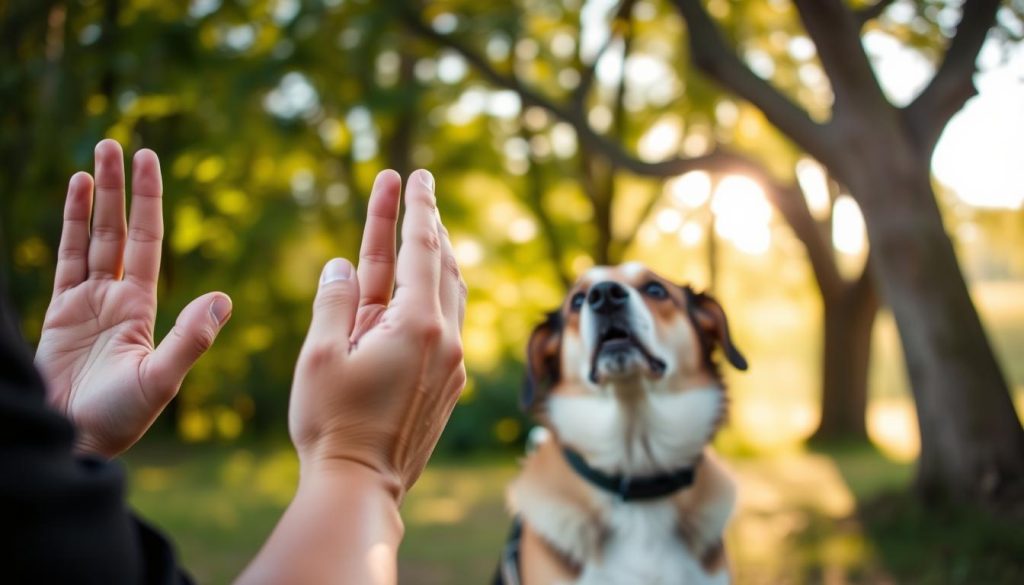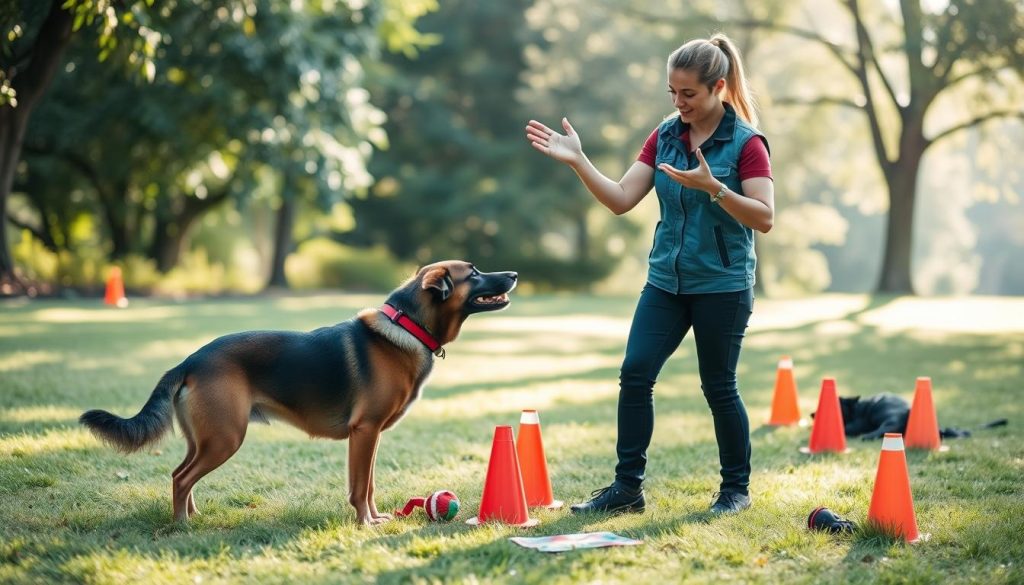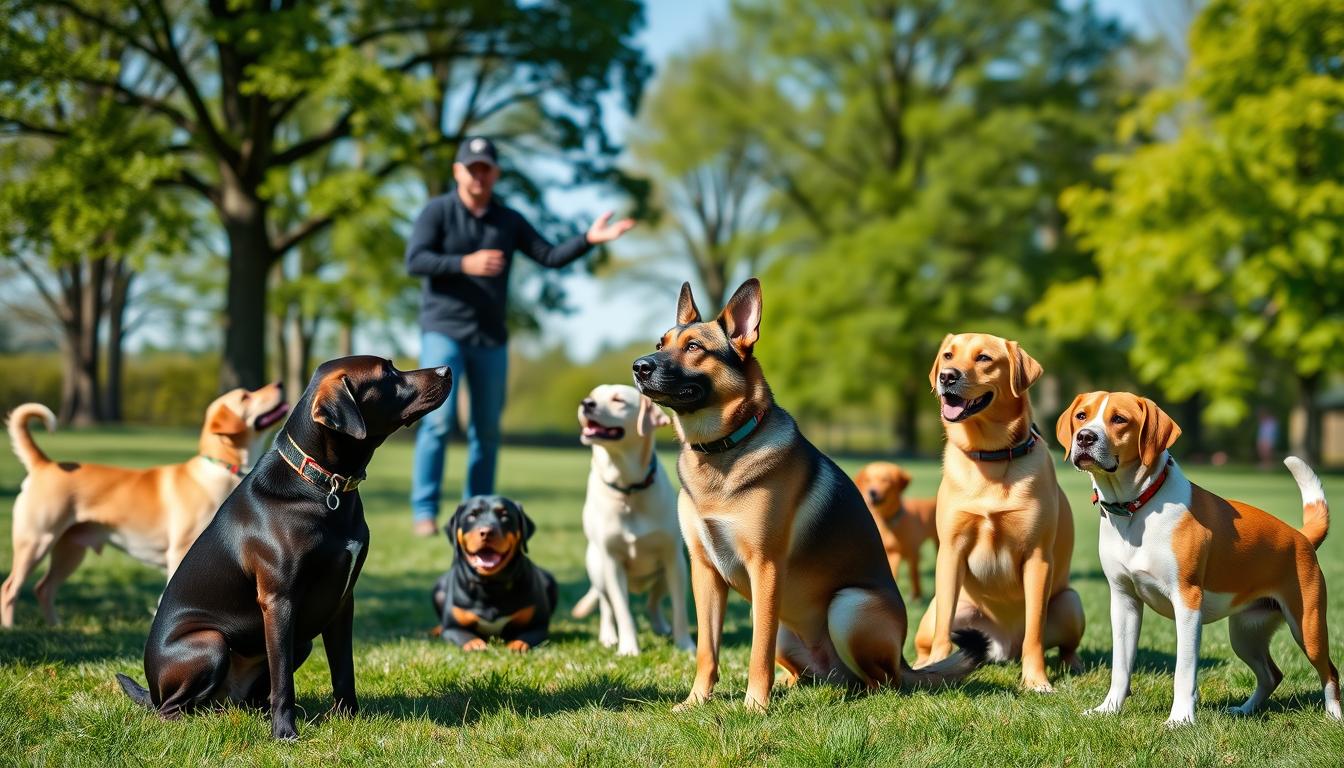Ever wondered how top dog trainers talk to their dogs so easily? The answer is hand signals. This guide will show you how using hand signals can change your dog training. It can make your bond stronger, improve obedience, and help you understand each other better.
Imagine training your dog with just a wave of your hand or a simple gesture. No need for endless talking or treats. Hand signals are a powerful way to communicate with your dog, beyond words.
Understanding the Importance of Hand Signals
Effective dog training goes beyond just using words. It also includes non-verbal cues, or hand signals. These silent commands are a big help in your dog training kit. They offer special benefits that add to traditional training methods.
Hand signals are great for getting your dog’s attention, especially in loud places. When words get lost in the noise, a hand signal can quickly get your dog’s focus back. This is super useful in public or during competitions where distractions are everywhere.

Quick Recommendation : Our blog is filled with tips , tricks, and methods for training your dog. If you would like to attend a Free Dog Training Workshop, we recommend the K9 Training Institute.
Also, hand signals are a big plus for dogs with hearing problems or in noisy places. They let you communicate with your dog even when words don’t work. This is true when training from far away or in loud spots.
Adding hand signals to your training can make your bond with your dog stronger. Learning these silent cues helps you guide your dog in many situations. It makes your relationship with your dog more understanding and confident.
Establishing a Clear Communication System
Effective dog training relies on clear communication. A set of hand signals helps your dog understand and follow commands. This builds a strong bond between you and your dog.
Start with simple commands like “sit,” “stay,” and “come.” Add more complex signals as your dog learns. Always use the same hand signals for each command. This helps your dog connect the signal with the action.
Using dog-friendly communication makes training clear and empowering for your dog. As your dog learns, training becomes easier and your bond grows stronger.

Quick Recommendation : Our blog is filled with tips , tricks, and methods for training your dog. If you would like to attend a Free Dog Training Workshop, we recommend the K9 Training Institute.
Creating a clear communication system sets your dog up for success. With consistent and intuitive commands, you’re on the path to a well-trained and harmonious pup.
The Power of Hand Signals in Dog Training
Unlock your dog’s full potential with hand signals. They work great with positive reinforcement, obedience training, and behavior modification. Clicker training shows how hand signals can make training better.
Hand signals can make a big difference in your dog’s training. They help you communicate clearly, which strengthens your bond. They’re especially helpful for dogs with hearing issues or in loud places.
Learning hand signals takes time, but it’s worth it. They improve your dog’s obedience and behavior. With hand signals, your dog’s training will get better, making your relationship more enjoyable.
Teaching Basic Hand Signals
Learning hand signals is key in dog training. Start with the basics like “sit,” “stay,” “come,” “down,” and “heel.” These commands are the foundation for more complex training and strengthen your bond with your dog.
First, teach the “sit” command. Hold your hand, palm-up, in front of your dog’s face. Gently push their rump down as you say “sit.” Praise and treat them when they sit. As they get better, move further away from them.
The “stay” command is next. Have your dog sit, then hold your palm out towards them, fingers spread. Say “stay” and reward them for staying put. Increase the time and distance as they learn.
Teaching “come” is important for safety. Stand a few feet away, crouch down, and use an open palm to call them. Praise and treat them when they come. Gradually increase the distance to test their response.
Learning these basic hand signals improves your dog’s training and your bond. Practice regularly and use positive reinforcement. Enjoy the journey and the rewards of a well-trained dog.
Advancing to More Complex Commands
Once your dog knows the basic hand signals, it’s time for more. This is where hand signals really show their power. They let you use your dog’s brain and grow your bond through cool training.
Begin with hand signals for harder tricks like “roll over,” “spin,” or “play dead.” These commands test your dog’s thinking and keep their mind sharp. Hand signals help your dog learn these complex actions, making your communication stronger.
As your dog gets better at hand signals, try trick training. Teach them to “shake,” “high five,” or “wave” with special hand signals. This amazes people and boosts your dog’s brain power and your bond.
Learning advanced commands and tricks shows your dog’s smarts and your skill in talking to them. With patience, consistency, and knowing how dogs think, you can reach your dog’s full potential.
Reinforcing Hand Signals Through Positive Reinforcement
Effective hand signal training needs consistent positive reinforcement. Use rewards, praise, and other motivational techniques to help your dog learn. This method not only shapes their behavior but also boosts their motivation to follow your cues.
Positive reinforcement is a key tool in dog training. It encourages the right behavior and strengthens your bond with your dog. When your dog gets a hand signal right, reward them with treats, affection, or their favorite toy. This positive feedback links the hand signal to the action, making your dog more likely to do it again.
Verbal praise also plays a big role in reinforcing hand signal training. Saying “Good job!” or “Well done!” can greatly boost your dog’s confidence. Combining physical rewards with positive words creates a strong system that taps into your dog’s love for praise.
Consistency is crucial for effective hand signal reinforcement. Stick to a structured, reward-based training plan. Your dog will soon learn to connect hand signals with actions, becoming more responsive and motivated.
Mastering Timing and Distance
Getting your hand signal training right means mastering timing and distance. It’s key for your dog to quickly follow your commands, no matter where you are. This helps keep your dog focused and obedient in different places.
Timing is key when giving hand signals. Your dog must link the visual cue with the action it should do. Try different signal lengths and speeds to see what works best. As your dog gets better, make your signals faster and more precise.
How far apart you are also matters. Start close and then move further away. This helps your dog learn to listen to you, even when you’re not right next to them. Make sure your training works in all kinds of places.
Mastering timing and distance in hand signals unlocks their full potential. Your dog will learn to follow your commands quickly and accurately. This lets you control and communicate with your dog in many situations. Keep practicing and be flexible to succeed in this important part of dog training.
Quick Recommendation : Our blog is filled with tips , tricks, and methods for training your dog. If you would like to attend a Free Dog Training Workshop, we recommend the K9 Training Institute.
Troubleshooting Common Challenges
Every training journey has its hurdles, and hand signal training is no different. You’ll face a few common challenges as you start. One big issue is hand signal confusion. Your dog might find it hard to tell different hand cues apart.
To solve this, be patient and repeat the training. Make sure your dog knows what each signal means. This way, they’ll learn to associate each cue with the right action.
Environmental distractions can also get in the way. Noises, sights, and smells might distract your dog. To fix this, train in a quiet place first. Then, slowly add more distractions as your dog gets better.
Positive reinforcement and behavior modification can help too. They teach your dog to ignore distractions and focus on your hand signals.
Sometimes, your dog might stop responding to hand signals. This could mean there’s a deeper issue that needs more work. Stay calm, watch your dog’s body language, and adjust your training if needed.
Remember, every dog learns at their own speed. So, celebrate the small wins along the way.
Incorporating Hand Signals into Daily Life
Adding hand signals to your daily talks with your dog can really boost your connection. It makes everyday tasks and fun activities easier. Hand signals can become a natural part of your dog’s life.
At home, hand signals are great for mealtimes, play, and grooming. Simple gestures like “sit,” “stay,” or “come” can make your days smoother. It helps you and your dog understand each other better.
Going outside with your dog? Hand signals are a big help. They let you give commands without disturbing others. Whether walking or hiking, hand signals keep your dog focused and under control.
Using hand signals every day strengthens your bond and makes life better for both of you. It’s a simple way to improve your daily routines and enjoy more time together. Start using hand signals and see how it changes your life with your dog.
The Benefits of Hand Signals for Competitive Dog Sports
For dog owners who love competitive sports, learning hand signals is key. These visual cues help a lot in dog competitions like obedience trials and agility events. Using hand signals in training can boost your dog’s skills and your partnership.
In obedience trials, clear communication is essential. Hand signals help you give commands clearly. This ensures your dog responds quickly and correctly, even with distractions around.
In agility competitions, hand signals are super helpful. They guide your dog through the course, keeping control while your dog focuses. This leads to faster times and better performances, helping you win.
Hand signals also help in daily life. They’re great for training in loud places or when you can’t speak. With practice and positive feedback, you and your dog can communicate smoothly. This strengthens your bond.
Conclusion
In this guide, you’ve learned how hand signals can change dog training. Using these visual cues can make training better, strengthen your bond, and improve obedience.
This article has given you the tools to understand and connect with your dog better. Start using hand signal training and see how it improves your skills.
Keep practicing and using positive reinforcement with hand signals. This will help your dog understand them better and deepen your bond. Look at the benefits summary of hand signals and add them to your dog’s routine. The next steps are clear – keep learning, practicing, and celebrating your progress together.
Quick Recommendation : Our blog is filled with tips , tricks, and methods for training your dog. If you would like to attend a Free Dog Training Workshop, we recommend the K9 Training Institute.

